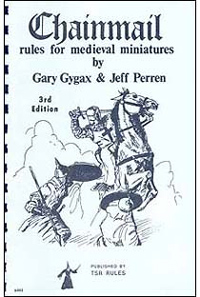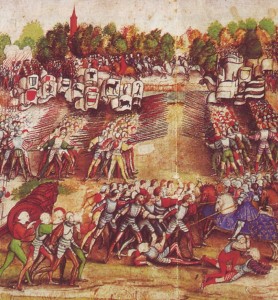As a new-school D&D player, there’s a lot of D&D history I’ve missed. Editing Cheers Gary, gaming with Mike Mornard, and illustrating the AD&D Dungeon Generator have helped, but there’s a lot in D&D that I still don’t understand. I’m going back to the OD&D texts to see whether they can help my new-school game.
 I decided to start with the original fantasy roleplaying game: Chainmail!
I decided to start with the original fantasy roleplaying game: Chainmail!
I’m not a war-gamer, so I expected to get bogged down in pages of elliptical rules that only made sense to other wargamers. I have to say, it was much more readable than I thought!
For the most part, Chain Mail uses a simple system, and most of the rules seem like rulings – fairly logical rulings – on corner cases, mostly involving how awesome awesome Swiss and Landsknechte pikemen are.
Double all penalties for poorly trained troops, and half for Swiss/Landsknechte and horse.
…
Only Swiss and Landsknechte pikemen can form a hedgehog. If ten or more of these troops are in a square-type formation, pikes or pole arms facing outwards in all four directions, a “hedgehog” has been constituted.
…
Swiss/Landsknechte Pike Charge: Because of the reputation and ferocity of these troops, an enemy charged by Swiss or Landsknechte pikemen (other than like troops) must roll two dice and consult the Loss Table, just as if they had suffered excess casualties.
…
Swiss and Landsknechte armed with pikes or pole arms facing the enemy automatically stand any charges.
…
Swiss/Landsknechte attacking in close formation ( 5 x 2 figures minimum) fight as Armored Foot, with extra die for weapons. For every two men so attacking as additional “mass shock” die is added.

At the Battle of Marignano, Swiss pikemen actually fought Landsknecht mercenaries. Because it was impossible for either side to lose, THE BATTLE IS STILL GOING ON.
The 45-page book manages to find room for rules for sieges, and … jousting! Not to mention the 13-page Fantasy Supplement that kicked off this whole D&D thing.
There are a few rules that make me scared to play. For instance:
FATIGUE
Continued activity brings on weariness:
1. Moving 5 consecutive turns.
2. Moving 2 consecutive turns, charging, then meleeing.
3. Moving 1 turn, charging, then meleeing 2 rounds.
4. Meleeing three rounds.
(Except of course that Swiss/Landsknechte can go twice as long in every category before getting fatigued. OF COURSE they can.)
When I read these fatigue rules, I realized how much recordkeeping is involved in this game. Every turn, you have to write down every unit’s move – even if you’re not using the optional “written orders” rule variation. Not only that, you have to look back through your notes to see if each of your units have rested in the past 5 turns, etc. I’d think this would slow the pace way down. How are you going to get through Waterloo in one day at this rate?
There’s also a bunch of stuff you have to reevaluate at the half-move (after the unit has moved half its movement rate). Melee and archery can take place at the half-move and at the end of the move. I wondered why every unit’s movement rate wasn’t just cut in half and one turn cut into two. I’m sure there’s a reason, though.
I’m kind of surprised to say this, but I would… play… Chainmail. I’m just throwing that out there, guys. Any beardos in New York with a sand table?







